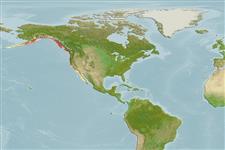Common names from other countries
Environment: milieu / climate zone / depth range / distribution range
Écologie
; profondeur 0 - 40 m (Ref. 290). Temperate
Distribution
Pays | Zones FAO | Écosystèmes | Occurrences | Introductions
Eastern Pacific.
Length at first maturity / Taille / Poids / Âge
Maturity: Lm ? range ? - ? cm Max length : 13.0 cm TL mâle / non sexé; (Ref. 290)
Description synthétique
Morphologie
Girdle: Black leathery covering almost the entire dorsal area. Dorsal ridge area of each valve: small portion; left exposed (Ref. 296).
Surf-zone to 40 m. Usually found on stony or rocky bottoms (Ref. 290); in the middle intertidal zone from Alaska to Point Conception; North of Santa Barbara; also on rocky shore with heavy wave action (Ref. 312). Herbivorous, feeding primarily on red and green algae and benthic diatoms (Ref. 312).
Life cycle and mating behavior
Maturité | Reproduction | Frai | Œufs | Fécondité | Larves
Members of the class Polyplacophora are mostly gonochoric. Life cycle: Eggs hatch into lecitotrophic planktonic trocophore larvae (no veliger stage) which later metamorphose and settle on the bottom as young adults.
Burghardt, G. and L. Burghardt. 2006. (Ref. 296)
Statut dans la liste rouge de l'IUCN (Ref. 130435)
statut CITES (Ref. 108899)
Not Evaluated
Not Evaluated
Utilisations par l'homme
| FishSource |
Outils
Plus d'informations
Taille/ÂgeCroissanceLongueur-poidsLongueur-longueurMorphologieLarvesAbondance
Sources Internet
Estimates based on models
Preferred temperature
(Ref.
115969): 6.1 - 10.9, mean 8.9 (based on 94 cells).
Vulnérabilité
Low vulnerability (10 of 100).
Catégorie de prix
Unknown.
